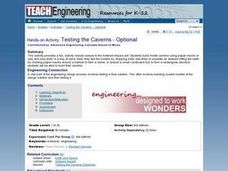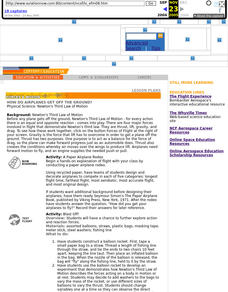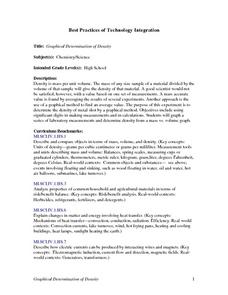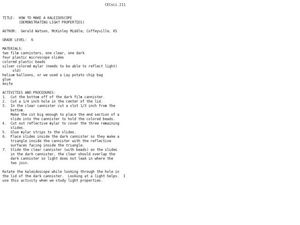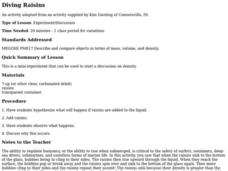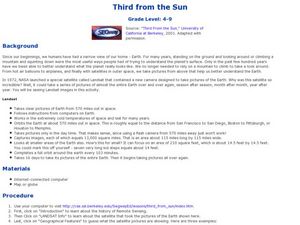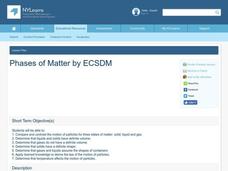Curated OER
The Mystery of the Sponge
First graders observe while water is absorbed into a sponge. They experiment by putting a sponge on yardstick and watch while water dries and the weight changes.
Curated OER
Ready to Erupt!
Students observe a visual representation of a volcano erupting. They measure and sketch the volcano and discuss how engineers use this information. They discover the type of equipment used to indicate an eruption.
Curated OER
TE Activity: Testing the Caverns
Students make model caverns out of paper mache or clay. They bury them in a tray of sand, and test the models by dropping balls into them simulating as asteroid hitting the earth. They discuss the results of the activity in a whole class...
Curated OER
How Do Airplanes Get Off the Ground
Pupils construct various types of paper airplanes, exploring action and reaction forces by conducting a paper airplane rodeo. Students then discuss how Newton's Third Law of Motion affected their planes.
Curated OER
Liquid Crystal IR Detector
Students experiment with one method of detecting infrared radiation. They simulate the detection of infrared radiation using a liquid crystal sheet.
Curated OER
Graphical Determination of Density
Students determine the density of metal shot by a graphical method using significant digits in making measurements and calculations. Students graph a seris of laboratory measurements and determine density from a mass verses volume graph.
Curated OER
Have You Ever Wondered?
Students use their personal knowledge and the Internet to discover where and how spiders live. In groups, they discuss their experiences with spiders and how their lives differ from other insects. They use new vocabulary to discuss their...
Curated OER
Don't Marry the Mole!
Third graders examine the power of solar energy. In groups, they create their own pizza box solar oven to discover the power of the sun and how it is a source for heat and light. To end the lesson, they use the internet to examine...
Curated OER
Periodic Table
Students relate to the idea of periodicity & give example of other periodic events and identify and use the periodic table as a useful resource. They also identify the relationship of elements to certain groups & periods &...
Curated OER
Facts of Matter
Students make group decisions about matter as they explore and interpret many types.
Curated OER
Cancer Warrior
Students perform an experiment to determine how different salt concentrations affect the liver's ability to break down toxic hydrogen peroxide. They record and average their data which is then graphed.
Curated OER
One-Way Valves
Students explore how the heart pumps blood through its valves. They observe fluid moving through a one-way valve and build a model of a valve. in addition, they explore biotechnology design.
Curated OER
The Opposable Thumb
Students explore the physical importance of the opposable thumb among primates. They discover which of their simplest daily activities are possible only because of their opposable thumbs.
Curated OER
States of Matter
First graders break into groups of five students and are given 15 different objects and 3 posters. They group the objects into 3 different families with all the objects in each category placed on one of the posters. They choose whatever...
Curated OER
Visit to the Local Weather Station
Students understand the preparation involved everyday to present the day's forecast and how the instruments are used to create an overall model for predicting weather. They will understanding of the terminology and symbols used in...
Curated OER
Activity #5 'Empty' Bag?
Students review that air is a form of matter. They investigate how air takes up space. Pupils comprehend that they cannot see air, it takes up space and has mass, therefore it is a form of matter. Students investigate how to show that...
Curated OER
What's Under There?
Young scholars determine ways to make "observations" about unknowns, such as the land beneath an ice sheet or the interior of the Earth, using tools other than sight. They build "mystery boxes" and exchange them with other groups to...
Curated OER
Plastics and Rubber: What's the Difference?
Students observe how to classify things into groups based on physical properties. In this plastic and rubber lesson students group and sort items to help them to better identify properties.
Curated OER
MTV no PTV
Students study the gas laws in particular the three variables; pressure, temperature and volume. In this gas laws lesson plan students complete an activity and discuss their findings.
Curated OER
How to Make a Kaleidoscope
Sixth graders create a kaleidoscope. In this light refraction lesson, 6th graders create a kaleidoscope to investigate the properties of light.
Curated OER
Microorganism Multiplication
Seventh graders complete two experiments to learn about harmful and helpful microorganisms. In this microorganisms lesson, 7th graders read background information about fungi, yeast, and club fungi. Students then complete two experiments...
Curated OER
Diving Raisins
Students participate in a mini lab to explore density. In this density lesson students view a demonstration and answer questions.
Curated OER
Third from the Sun
Students examine images from space. In this third from the Sun lesson plan, students examine images from, Landsat, the satellite launched by NASA in 1972.
Curated OER
Phases of Matter
Students describe the motion of solids, liquids and gases. In this chemistry lesson, students describe how temperature affect motion of the particles. They determine the physical properties of each phase.


